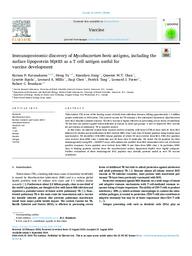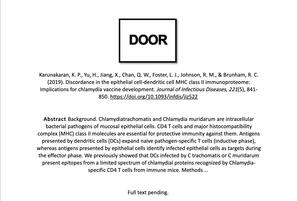Chan, Queenie W.T.
Person Preferred Name
Queenie W.T. Chan
Related Works
Content type
Digital Document
Abstract
Tuberculosis (TB) is one of the leading causes of death from infectious diseases, killing approximately 1.3 million people worldwide in 2022 alone. The current vaccine for TB contains a live attenuated bacterium, Mycobacterium bovis BCG (Bacille Calmette-Guérin). The BCG vaccine is highly effective in preventing severe forms of childhood TB but does not protect against latent infection or disease in older age groups. A new or improved BCG vaccine for prevention of pulmonary TB is urgently needed.
In this study, we infected murine bone marrow derived dendritic cells from C57BL/6 mice with M. bovis BCG followed by elution and identification of BCG-derived MHC class I and class II-bound peptides using tandem mass spectrometry. We identified 1436 MHC-bound peptides of which 94 were derived from BCG. Fifty-five peptides were derived from MHC class I molecules and 39 from class II molecules. We tested the 94 peptides for their immunogenicity using IFN- γ ELISPOT assay with splenocytes purified from BCG immunized mice and 10 showed positive responses. Seven peptides were derived from MHC II and three from MHC class I. In particular, MHC class II binding peptides derived from the mycobacterial surface lipoprotein Mpt83 were highly antigenic. Further evaluations of these immunogenic BCG peptides may identify proteins useful as new TB vaccine candidates.
Origin Information
Content type
Digital Document
Abstract
Abstract
Background
Chlamydiatrachomatis and Chlamydia muridarum are intracellular bacterial pathogens of mucosal epithelial cells. CD4 T cells and major histocompatibility complex (MHC) class II molecules are essential for protective immunity against them. Antigens presented by dendritic cells (DCs) expand naive pathogen-specific T cells (inductive phase), whereas antigens presented by epithelial cells identify infected epithelial cells as targets during the effector phase. We previously showed that DCs infected by C trachomatis or C muridarum present epitopes from a limited spectrum of chlamydial proteins recognized by Chlamydia-specific CD4 T cells from immune mice.
Methods
We hypothesized that Chlamydia-infected DCs and epithelial cells present overlapping sets of Chlamydia-MHC class II epitopes to link inductive and effector phases to generate protective immunity. We tested that hypothesis by infecting an oviductal epithelial cell line with C muridarum, followed by immunoaffinity isolation and sequencing of MHC class I- and II-bound peptides.
Results
We identified 26 class I-bound and 4 class II-bound Chlamydia-derived peptides from infected epithelial cells. We were surprised to find that none of the epithelial cell class I- and class II-bound chlamydial peptides overlapped with peptides presented by DCs.
Conclusions
We suggest the discordance between the DC and epithelial cell immunoproteomes has implications for delayed clearance of Chlamydia and design of a Chlamydia vaccine.
Origin Information


